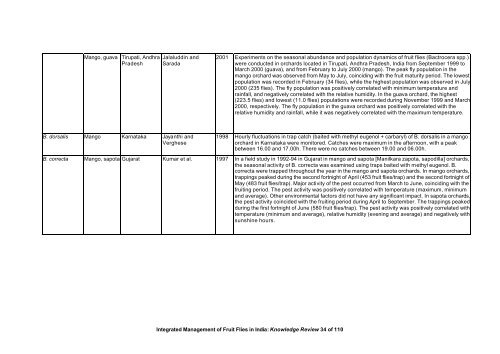“Key Informant Survey” of Production, Value, Losses and ... - DfID
“Key Informant Survey” of Production, Value, Losses and ... - DfID
“Key Informant Survey” of Production, Value, Losses and ... - DfID
You also want an ePaper? Increase the reach of your titles
YUMPU automatically turns print PDFs into web optimized ePapers that Google loves.
Mango, guava Tirupati, Andhra<br />
Pradesh<br />
Jalaluddin <strong>and</strong><br />
Sarada<br />
B. dorsalis Mango Karnataka Jayanthi <strong>and</strong><br />
Verghese<br />
2001 Experiments on the seasonal abundance <strong>and</strong> population dynamics <strong>of</strong> fruit flies (Bactrocera spp.)<br />
were conducted in orchards located in Tirupati, Andhra Pradesh, India from September 1999 to<br />
March 2000 (guava), <strong>and</strong> from February to July 2000 (mango). The peak fly population in the<br />
mango orchard was observed from May to July, coinciding with the fruit maturity period. The lowest<br />
population was recorded in February (34 flies), while the highest population was observed in July<br />
2000 (235 flies). The fly population was positively correlated with minimum temperature <strong>and</strong><br />
rainfall, <strong>and</strong> negatively correlated with the relative humidity. In the guava orchard, the highest<br />
(223.5 flies) <strong>and</strong> lowest (11.0 flies) populations were recorded during November 1999 <strong>and</strong> March<br />
2000, respectively. The fly population in the guava orchard was positively correlated with the<br />
relative humidity <strong>and</strong> rainfall, while it was negatively correlated with the maximum temperature.<br />
1998 Hourly fluctuations in trap catch (baited with methyl eugenol + carbaryl) <strong>of</strong> B. dorsalis in a mango<br />
orchard in Karnataka were monitored. Catches were maximum in the afternoon, with a peak<br />
between 16.00 <strong>and</strong> 17.00h. There were no catches between 19.00 <strong>and</strong> 06.00h.<br />
B. correcta Mango, sapota Gujarat Kumar et al. 1997 In a field study in 1992-94 in Gujarat in mango <strong>and</strong> sapota [Manilkara zapota, sapodilla] orchards,<br />
the seasonal activity <strong>of</strong> B. correcta was examined using traps baited with methyl eugenol. B.<br />
correcta were trapped throughout the year in the mango <strong>and</strong> sapota orchards. In mango orchards,<br />
trappings peaked during the second fortnight <strong>of</strong> April (453 fruit flies/trap) <strong>and</strong> the second fortnight <strong>of</strong><br />
May (483 fruit flies/trap). Major activity <strong>of</strong> the pest occurred from March to June, coinciding with the<br />
fruiting period. The pest activity was positively correlated with temperature (maximum, minimum<br />
<strong>and</strong> average). Other environmental factors did not have any significant impact. In sapota orchards,<br />
the pest activity coincided with the fruiting period during April to September. The trappings peaked<br />
during the first fortnight <strong>of</strong> June (580 fruit flies/trap). The pest activity was positively correlated with<br />
temperature (minimum <strong>and</strong> average), relative humidity (evening <strong>and</strong> average) <strong>and</strong> negatively with<br />
sunshine hours.<br />
Integrated Management <strong>of</strong> Fruit Flies in India: Knowledge Review 34 <strong>of</strong> 110

















